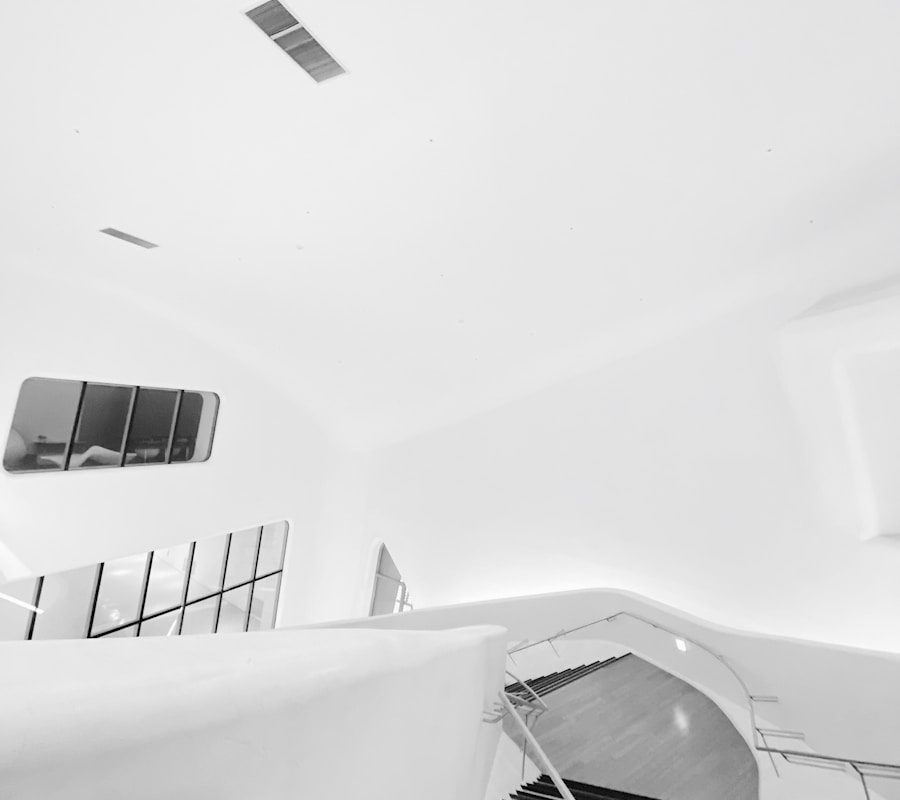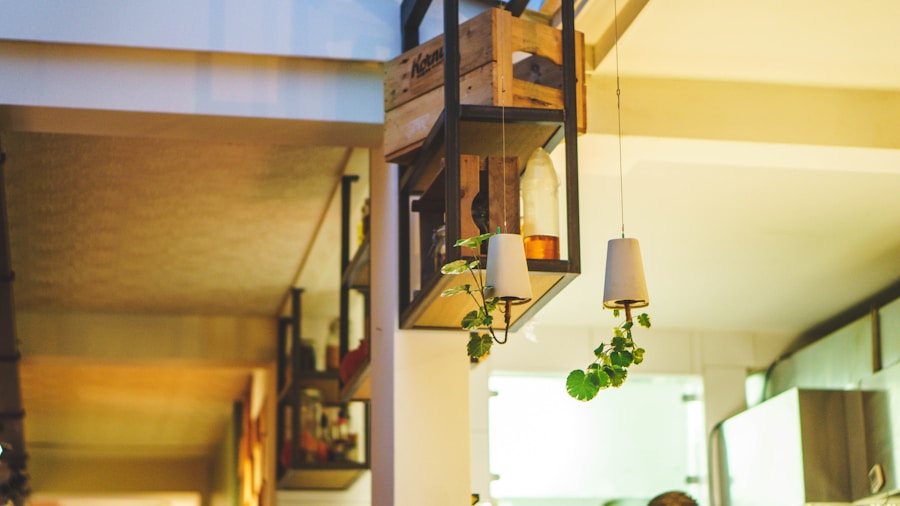Modern loft design is a distinctive architectural style that has evolved from the adaptive reuse of industrial spaces into residential and commercial environments. Originally, lofts were large, open spaces in warehouses or factories, characterized by high ceilings, exposed beams, and large windows. This design ethos embraces the raw, unfinished aesthetic of industrial architecture while incorporating contemporary elements that cater to modern living.
The essence of loft design lies in its ability to blend functionality with artistic expression, creating spaces that are not only visually striking but also practical for everyday use. The appeal of modern loft design extends beyond mere aesthetics; it reflects a lifestyle choice that values openness and flexibility. In a world where urban living often means limited space, lofts offer a unique solution by maximizing usable area.
The open layout encourages creativity and adaptability, allowing residents to personalize their environments according to their needs and preferences. This design philosophy champions the idea that living spaces should be as dynamic as the lives of those who inhabit them, fostering an atmosphere of innovation and individuality.
Utilizing Open Floor Plans
Open floor plans are a hallmark of modern loft design, promoting a sense of spaciousness and fluidity within the living environment. By eliminating unnecessary walls and barriers, these layouts create a seamless flow between different areas of the home, such as the kitchen, dining, and living spaces. This design choice not only enhances the visual appeal of the loft but also encourages social interaction among family members and guests.
The absence of walls allows for unobstructed sightlines, making the space feel larger and more inviting. Moreover, open floor plans can be particularly advantageous in urban settings where square footage is often at a premium. By maximizing the available space, residents can enjoy a more functional living area without sacrificing style.
The versatility of an open layout allows for various configurations of furniture and decor, enabling homeowners to adapt their spaces for different occasions or activities. For instance, a cozy gathering with friends can easily transform into a spacious area for entertaining larger groups, showcasing the adaptability that open floor plans offer.
Incorporating Industrial Elements
Industrial elements are integral to modern loft design, paying homage to the historical roots of these spaces while adding character and depth. Exposed brick walls, concrete floors, and steel beams are common features that evoke the industrial past of lofts. These raw materials not only contribute to the aesthetic appeal but also serve as a reminder of the building’s history, creating a unique narrative within the home.
The juxtaposition of these rugged elements with contemporary furnishings can result in a striking visual contrast that defines modern loft living. Incorporating industrial elements goes beyond mere decoration; it involves embracing the imperfections that come with such materials. For example, a weathered wooden beam or a rusted metal fixture can become a focal point in the design, adding authenticity and charm to the space.
Additionally, these materials are often durable and low-maintenance, making them practical choices for busy urban lifestyles. By thoughtfully integrating industrial features into the overall design scheme, homeowners can create an environment that is both stylish and resilient.
Maximizing Natural Light
Natural light is a crucial component of modern loft design, enhancing the overall ambiance and making spaces feel more open and inviting. Large windows are a defining characteristic of lofts, allowing sunlight to flood in and illuminate the interior. This abundance of natural light not only contributes to the aesthetic appeal but also has numerous psychological benefits, such as improving mood and productivity.
In urban environments where outdoor space may be limited, harnessing natural light becomes even more essential for creating a sense of connection to the outside world. To maximize natural light in a loft, strategic placement of mirrors and reflective surfaces can amplify brightness throughout the space. For instance, positioning a large mirror opposite a window can create an illusion of depth while bouncing light around the room.
Additionally, choosing lighter color palettes for walls and furnishings can further enhance the effect of natural light, making the space feel airy and expansive. Incorporating sheer window treatments allows for privacy while still permitting sunlight to filter through, striking a balance between openness and seclusion.
Selecting the Right Furniture and Decor
The selection of furniture and decor plays a pivotal role in defining the character of a modern loft. Given the open nature of these spaces, choosing pieces that complement one another while maintaining individual style is essential. Furniture should be functional yet aesthetically pleasing, with an emphasis on clean lines and minimalist designs that align with the overall ethos of modern loft living.
Multi-functional furniture pieces, such as ottomans with storage or extendable dining tables, can maximize utility without overwhelming the space. In addition to furniture selection, decor choices should reflect personal taste while harmonizing with the industrial elements present in the loft. Artwork can serve as a powerful statement piece; large-scale paintings or sculptures can draw attention and add vibrancy to an otherwise neutral palette.
Textiles such as rugs and cushions can introduce warmth and comfort, softening the starkness of industrial materials while providing tactile contrast. By curating a thoughtful collection of furniture and decor, homeowners can create an environment that feels cohesive and inviting.
Creating Storage Solutions
Maximizing Vertical Space
Utilizing vertical space is one effective strategy; tall bookshelves or wall-mounted cabinets can draw the eye upward while providing ample storage without consuming valuable floor area. This approach not only maximizes functionality but also enhances the sense of height within the loft.
Multifunctional Furniture
Another innovative storage solution involves incorporating furniture that doubles as storage units. For example, benches with hidden compartments or coffee tables with shelving can provide practical storage while serving their primary functions.
Style Meets Functionality
Additionally, utilizing under-bed storage or decorative baskets can help keep clutter at bay without sacrificing style. By thoughtfully integrating storage solutions into the design scheme, homeowners can maintain an organized environment that reflects their personal style while accommodating their lifestyle needs.
Incorporating Technology
In today’s digital age, incorporating technology into modern loft design is essential for creating a comfortable and efficient living environment. Smart home technology offers numerous benefits, from enhancing security to improving energy efficiency. For instance, smart thermostats can optimize heating and cooling based on occupancy patterns, reducing energy consumption while maintaining comfort levels.
Additionally, smart lighting systems allow homeowners to control brightness and ambiance through mobile devices or voice commands, adding convenience to daily routines. Moreover, integrating technology into entertainment systems can elevate the overall living experience in a loft. High-quality sound systems or built-in speakers can enhance movie nights or gatherings with friends, while smart TVs provide access to streaming services without cluttering surfaces with additional devices.
The key is to ensure that technology complements rather than overwhelms the design aesthetic; sleek devices that blend seamlessly with decor can enhance functionality without detracting from the overall visual appeal.
Balancing Aesthetics and Functionality
Achieving a balance between aesthetics and functionality is crucial in modern loft design. While it is tempting to prioritize visual appeal, it is essential to consider how each element contributes to everyday living. A well-designed loft should not only look good but also serve its inhabitants’ needs effectively.
This balance can be achieved through thoughtful planning and consideration of how each space will be used on a daily basis. For example, while an eye-catching piece of art may serve as a focal point in the living area, it should not obstruct pathways or hinder movement within the space. Similarly, while selecting furniture that enhances visual interest is important, it should also provide comfort and usability for daily activities.
By carefully evaluating each design choice through both aesthetic and functional lenses, homeowners can create a harmonious environment that reflects their personal style while accommodating their lifestyle needs effectively.








